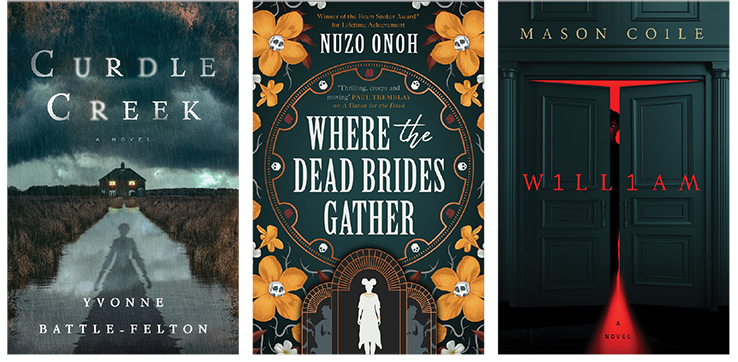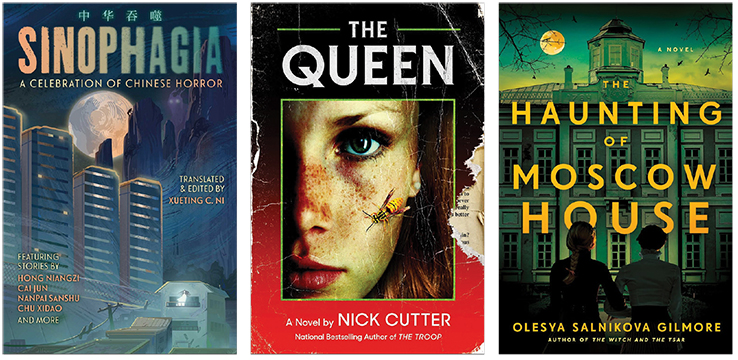Fiction Shows Its Fangs | Horror Fiction Preview 2024
Vampires stake a renewed claim, women’s stories and translated novels expand the genre, and psychological horror challenges tropes.
 Fall 2024 is a showcase of horror. A who’s who of authors have books publishing this season, underscoring the genre’s continued renaissance, the likes of which readers have not seen in decades—since Stephen King’s Carrie launched the last horror surge in the mid-20th century. This new era, however, reflects a significant change in the genre. The voices it marginalized for so long—women, LGBTQIA+ individuals, and people of color—are now leading the genre forward, channeling the horrors of their real-world existences into spectacularly terrifying tomes.
Fall 2024 is a showcase of horror. A who’s who of authors have books publishing this season, underscoring the genre’s continued renaissance, the likes of which readers have not seen in decades—since Stephen King’s Carrie launched the last horror surge in the mid-20th century. This new era, however, reflects a significant change in the genre. The voices it marginalized for so long—women, LGBTQIA+ individuals, and people of color—are now leading the genre forward, channeling the horrors of their real-world existences into spectacularly terrifying tomes.
By including more voices, the genre has not only allowed itself to blossom, but it has also brought more readers along for the terrifying ride. Gabino Iglesias, the New York Times Book Review horror columnist and award-winning horror novelist tells LJ, “We are in a new golden era of horror. The genre is healthier than ever and more diverse than it’s ever been, which means we’re getting horror narratives from a rich variety of perspectives and positionalities. We’re also seeing horror mixing with more genres than ever before, and that means that everyone can find horror they like, no matter what their reading preferences are.
“It’s a superb moment to be a fan of horror, or to become one,” Iglesias continues. “A great time to be a horror writer too. We were the weird kids not allowed to sit at Literature’s table, so we made our own with bones and a lot of swagger. Now we get to look out and proudly say we’re doing it our way, and everyone is welcome. Long live horror.”
As horror expands its reach, several key trends are emerging this season, including the return of the vampire, which sees the eternal creature that has been adopted by romance and fantasy coming back to the genre that birthed it. Psychological horror is also surging, reflecting society and underscoring a pervasive feeling of existential dread. Look as well for books in which women take control of the narrative and for horror novels in translation.
A downloadable list of all titles mentioned can be found here.
Vampires: Back From the (Un)Dead
While vampires, by definition, never die, the newest bloodsuckers are not only more terrifying than their more sparkly and immediate predecessors, but they are also being presented by authors who nuance the powerful, eternal evil by refracting it through the lens of their own lived experiences as members of marginalized communities. The critically acclaimed Hailey Piper puts a ghostly, gothic spin on vampires with All the Hearts You Eat (Titan), while Michelle McGill-Vargas’s American Ghoul (Blackstone) innovatively merges vampires with serious social commentary and the buddy-comedy trope. In We Love the Nightlife (Berkley), Rachel Koller Croft visits 1979 and London’s disco scene with a fast-paced tale of the toxic friendship between two women vampires. Two authors use classic literature as a frame for their new vampiric tales: In The Madness (Graydon House), Dawn Kurtagich claims names familiar to fans of Dracula to bring the classic into the present, depositing it on the atmospherically windswept shores of Wales, while Emma Newman puts her vampires in the swashbuckling world of Alexandre Dumas in The Vengeance (Solaris). Finally, Johnny Compton embraces a full roster of classic monsters, including vampires, in his heart-pounding sophomore Southern gothic, Devils Kill Devils (Tor Nightfire).
Of all the new voices staking their claim in horror—and vampires—no one might be as popular with the broadest audience as Rachel Harrison, whose upcoming novel So Thirsty (Berkley) is one of the most hotly anticipated books of 2024. Berkley Executive Editor Jessica Wade says, “Though vampires never really left us, it’s been exciting to see their comeback in recent years…. Rachel cleverly uses the immortal, unchanging nature of vampires as a foil to women’s concerns about aging (and the societal pressures that magnify those concerns), to nuanced effect.” Wade foresees even more vampiric literature to come, with interesting twists, as “the new generation of horror writers are working on fascinating subversions of older tropes.”
Psychological Horror
Psychological horror as a subgenre is not new, but in previous generations the majority of titles were set in hospitals or featured characters whom readers were led to believe had severe mental illness. In recent years, bestselling authors such as Paul Tremblay have gained popularity by challenging the trope with tales where unease seeps in from all sides, and nothing can be trusted to be as it appears. This immersive fear does not always manifest as a nameable monster, but there is clearly more occuring than meets the eye. The new psychological horror works to actively invest readers in the overall fear of the story, asking them to question themselves and leaving them with an existential dread that is nearly impossible to shake.
A leading example is the existentially terrifying and original Coup de Grâce (Titan) by Sofia Ajram, a mind-bending and visceral novel that traps a young man in the liminal space of a subway station. Ellen Datlow is exploring the subgenre in her upcoming anthology, Fears: Tales of Psychological Horror (Tachyon). Other examples not to miss focus on destabilizing the comfort and safety of home, including William (Putnam) by Mason Coile (pseudonym of Andrew Pyper), a novel that combines cyber noir and psychological horror, set in a house haunted by AI; We Came To Welcome You (Morrow) by Vincent Tirado, his chilling adult debut that follows a married couple who move into a gated community; and Ghost Mother (Union Square & Co.) by Kelly Dwyer, featuring a young couple and their new house that has a violent history.
Terrors of Womanhood
Important this season are novels that grapple with the full breadth of women’s experiences as daughters, friends, sisters, and mothers and showcase the inherent horror in every woman’s life. The essential feature of these books is that the women in them are not victims—they take control and fight back.
Leading the season is CJ Leede, who captivated readers in 2023 with her violent, disturbing, and, yes, fun debut, Maeve Fly. She is back with even more deviance in American Rapture (Tor Nightfire), which asks: What would you do if your sexual desires turned you into a monster? Other noteworthy examples include Katrina Monroe’s Through the Midnight Door (Poisoned Pen), an emotional and haunting look at sisters and generational trauma; Leslie J. Anderson’s The Unmothers (Quirk), a raw folk-horror tale contemplating women’s rage, bodily autonomy, and the secret guarded by the women of a small town; Dearest (Mulholland) by Jacquie Walters, about a new mom who seeks help from her estranged mother but quickly realizes she has let something even worse into her home; and Curdle Creek (Holt) by Yvonne Battle-Felton, set in a small town with a chilling tradition—a surreal gothic tale that does not shy away from social commentary while exploring themes of motherhood and belonging.
Worldwide Horror
Sadie Hartmann (author of 101 Horror Books To Read Before You’re Murdered and the co-owner of Nightworms, a popular horror-book subscription service) notes, “Horror readers are constantly on the prowl for something fresh, unique, and left of center—that’s nothing new, but where they’re currently finding these hot, buzzworthy titles [is in] translated fiction.” Eager to fulfill that hunger, publishers have turned to the treasure trove of horror voices from across the globe. Sinophagia: A Celebration of Chinese Horror (Solaris) is an examplar. Edited by Xueting C. Ni, this anthology contains 14 stories by contemporary Chinese horror authors, translated into English for the first time, featuring a wide range of scares, purposefully collected to defy Western expectations. Well-known science fiction writer Mary Robinette Kowal hopes to bring attention to Icelandic horror novelist Hildur Knútsdóttir with her translation of The Night Guest (Tor Nightfire), the gripping psychological tale of a young woman who wakes up exhausted every morning, only to figure out that she has been walking miles in her sleep. Where the Dead Brides Gather (Titan) by Nuzo Onoh and The Haunting of Moscow House (Berkley) by Olesya Salnikova Gilmore were both written in English, but they center the terrifying folklore of the authors’ early years in Nigeria and Russia, respectively.
The brightest star in international horror right now is the brilliant Argentinian author Mariana Enriquez, whose novel Our Share of Night captured the hearts of readers and critics last year. Her second story collection, A Sunny Place for Shady People (Hogarth; tr. from Spanish by Megan McDowell), presents character-centered tales of ghosts, the occult, and the macabre while exploring love, womanhood, the experiences of LGTBQIA+ people, and, always at the center of her work, a reckoning with Argentina’s brutal past.
Big Names, Big Books
Regularly garnering holds from the moment their next title is announced, winning awards, and making “best of the month” lists, the leading voices in horror are embracing the genre’s roots while injecting something new as well. A great example of this is Gabino Iglesias, who channels his personal rage into award-winning stories. Up next for the Bram Stoker and Shirley Jackson Award winner is House of Bone and Rain (Mulholland), which blurs myth and grim reality into a violent but lyrical tale of devotion. Grady Hendrix has built his career putting fresh spins on classic subgenres, and in Witchcraft for Wayward Girls (Berkley), he sets his sights on the evergreen witch tale. Speculative-fiction star Rivers Solomon looks at the haunted-house tale, turning the trope on its head with a terrifying story of ghosts and racism in Model Home (MCD). Other important books this season from mainstay authors include Clay McCloud Chapman’s Wake Up and Open Your Eyes (Quirk), a novel that chews on the horror of the political divide; Nick Cutter’s The Queen (Gallery), a sci-fi-tinged story of a missing best friend and the deadly secret hidden in her DNA; and Dear Hanna (Thomas & Mercer), the long-awaited sequel to Zoje Stage’s fan-favorite debut, Babyteeth: the terrifying child returns, now all grown up and facing her own parenting horrors.
Golden Era of Horror
Fast-forwarding from a teenage girl processing the terror of her world in Carrie to novels that claim space for themselves and push past boundaries others have drawn for them, the genre’s landscape is vibrant, fascinating, and expansive. This is a watershed moment to read and explore these books—as Iglesias proclaims it, a new golden era of horror.
Becky Spratford is the Library Journal horror columnist. Her latest book is The Readers’ Advisory Guide to Horror, Third Edition (ALA Editions, 2021). You can follow her reading adventures on her blog RA for All (raforall.blogspot.com) or on X @RAforAll.
Add Comment :-
ALREADY A SUBSCRIBER? LOG IN
We are currently offering this content for free. Sign up now to activate your personal profile, where you can save articles for future viewing











